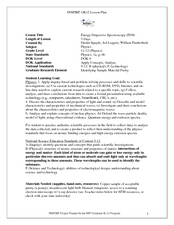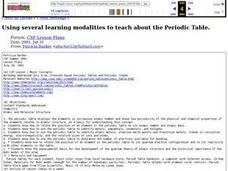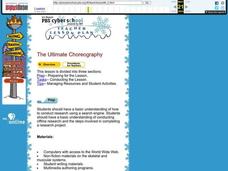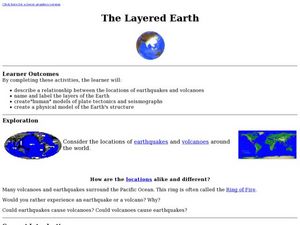Curated OER
Energy Dispersive Spectroscopy
Students calculate the values of electron binding energies. In this physics lesson plan, students solve for different wavelength characteristics of X-rays. They present their findings to the class.
Curated OER
2D Kinematics w/ String Racers
Students calculate the speed of string racers. In this physics instructional activity, students measure the time in several trials and get the average. They graph their results using a spreadsheet.
Curated OER
Using several learning modalities to teach about the Periodic Table.
Students identify how to relate the position of an element in the periodic table to its atomic number and atomic mass. They identify how to use the periodic table to identify metals, semimetals, nonmetals, and halogens, and also,...
Curated OER
Grating Spectrometer
Young scholars calculate the Balmer series. In this physics instructional activity, students observe hydrogen lamp spectra using spectrometers. They calculate wavelength and compare them with their theoretical calculations.
Curated OER
Numerical Determination of Drag Coefficients
Learners create a video of an object falling with a drag. In this physics instructional activity, students calculate drag coefficient using data from Logger Pro. They calculate velocity and acceleration of the object.
Curated OER
Investigation of Hooke's Law Lab
Students determine the spring constant by conducting an investigation. In this physics lesson, students collect data and create a graph of force vs. displacement. They compare the results of two different methods to find spring constant.
Curated OER
Ballistic Pendulum Lab
Learners determine the muzzle velocity of projectile launcher. In this physics instructional activity, students compare the pendulum method and kinematic method in calculating the initial velocity. They analyze data and discuss results...
Curated OER
Potato Launcher Energy Lab
Students investigate conservation laws using a potato launcher. In this physics lesson, students measure angles, time and distance of the potato. They discuss applications of experiments like this.
Curated OER
Construction of an Ammeter and a Voltmeter from a Galvanometer
Students explore series and parallel circuits. In this physics instructional activity, students construct a simple circuit and measure its maximum current. They construct their own voltmeter and ammeter that operates at a specified range.
Curated OER
"Bug Hunt"
Fourth graders find bugs represented on a grid and then identify their name and physical characteristics that provide a picture of the bug using imagery.
Curated OER
Investigation of Timbre
Pupils design an experiment to analyze the timbre of different instruments. In this physics lesson, students analyze the missing quality in sound. They discuss their results in class.
Curated OER
Periodic Table & Its Trends
Students review atomic structure and then participate in a activity in which they categorize several "elements" into some form of order based on their properties. They discuss the trends they see. They also practice several electron...
Curated OER
Robot Labyrinth
Young scholars design a flowchart for their robotic program. In this physics instructional activity, students construct a robot that can navigate certain obstacles. They present their program and robots in class.
Curated OER
Sensor Challenge
Students develop a pseudo code flowchart for their robotic program. In this physics lesson, students construct a robot that can navigate through certain obstacles. They test their robot and present them to class.
Curated OER
Mineral Lab
Eighth graders examine the physical properties of different minerals. In this earth science lesson, 8th graders explain the uses of minerals in their daily lives. They complete the mineral identification table during the lesson.
Curated OER
The Ultimate Choreography
Eighth graders research the required elements of the short programs in men's and women's figure skating. They analyze the physical requirements of each move and relate the types of muscles, bones, and joints required to perform them.
Curated OER
Go Green!
Learners use this outdoor sensory activity as a self-guided or as part of a facilitated programme. It encourages individual observation and exploration in the forest. Students can choose to work as an individual or work in pairs. They...
Curated OER
Finding and Measuring What You Can't See
Students determine how scientists measure pollutants in food and the environment. Students discover how scientists remove one material based on its physical properties. Students figure out how much of a pollutant is present after...
Curated OER
Hurricanes
Students state and directly experience two laws of Physics (Law of Gravity, Law of Centrifugal Force) that affect weather. They explain the observations made when using the "hurricane machine" and relate them to other events and phenomenon.
Curated OER
Periodic Table & Its Trends-Day 1
Learners are introduced to the periodic table. They find the common trends among the electron configurations and the names of certain groups of the table. Students explore the atomic mass, atomic number, mass number, mass and charge...
Curated OER
The Layered Earth
Students role play plate tectonics by creating a "plate statue" made up of students. In this earth science instructional activity, students describe how Earth's movement cause earthquakes and volcanoes. They draw and name the different...
Curated OER
Super Scientists Bingo
In this science worksheet, learners select twenty-five scientists from the list to fill in their bingo card. Then they match each of the scientists listed to their correct description strip.
Curated OER
Surviving in Our Ecosystems
Third graders identify the characteristics of a frog and compare them to a human child. They draw and describe the best environment for a human to live in and the best environment for a frog to live in based on their physical...
Curated OER
Radioactive Decay/Half Life
Students demonstrate radioactive decay using candy corns. In this Physics lesson, students make predictions, collect data and form conclusions about patterns in radioactive decay.























